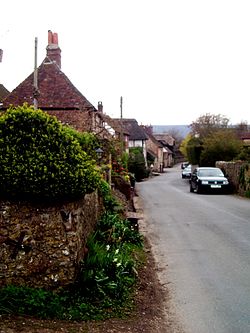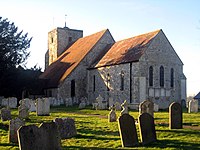Amberley, Sussex
| Amberley | |
| Gloucestershire | |
|---|---|
 Amberley | |
| Location | |
| Grid reference: | TQ031131 |
| Location: | 50°54’31"N, -0°32’3"W |
| Data | |
| Population: | 533 (2001) |
| Post town: | Arundel |
| Postcode: | BN18 |
| Dialling code: | 01798 |
| Local Government | |
| Council: | Horsham |
| Parliamentary constituency: |
Arundel and South Downs |
Amberley is a village in Sussex, at the foot of the South Downs. Its neighbours are Storrington, West Chiltington and Arundel. The village is noted for its many thatched cottages. There is one house in Amberley named "The Thatched House"; it is one of the village's few non-thatched houses.
One of the attractions in Amberley is Amberley Working Museum.
Amberley has its own station, Amberley Station, on the Arun Valley Line, with regular services to Bognor Regis, Portsmouth and London.
To the north of the village is the tidal plain of the River Arun, known as Amberley Wild Brooks. This wetland area floods in winter and is known for its wildfowl; it is denoted a Site of Special Scientific Interest. Good views can be had from the Sportsman Pub at the east end of the village, known as crossgates.
The Black Horse in the centre of the village often has Morris Dancing in the Summer. Amberley also has a castle, which is now a Hotel. The 'castle' is in fact a fortified manor house next to which is the church.
Parish church

The parish church is St Michael's. It is a Norman church with alter additions.
In the church, south of the chancel arch are 12th or 13th century wall-paintings, depicting scenes from the Passion Cycle.[1]
The largest memorial in the churchyard is to Edward Stott RA[2] who lived in Amberley from 1889 until he died in 1918. He is still famous for his rural scenes, many sketched close to Amberley. His monument has a bust on top carved by the sculptor Francis Derwent Wood. Wood's nearby grave is marked with one of his own works, a pieta in bronze. Inside the church is a semi-circular stained glass window to Stott, designed by Robert Anning Bell. Other windows have inscriptions by Eric Gill and his assistant Joseph Cribb.
Cultural links
William Champion Streatfeild, who was later Bishop of Lewes for a brief period, was vicar of Amberley with Houghton from 1897 to 1902. His daughter, the children's novelist Noel Streatfeild, spent part of her childhood there.[3] These may have been the happiest years of her childhood.[4]
Arnold Bennett, more famous for writing about life in the Potteries stayed in the village for eight weeks in 1926 and this stay is documented in his journals.[5] During May–June 1926, he wrote the last two thirds of The Vanguard in 44 days, noting I have never worked more easily than in the last six weeks. He also met John Cowper Powys who walked over the Downs from Burpham to visit him.[6]
Frank Swinnerton lived in Cranleigh and had links with Bennett, subsequently selecting and editing his Journals. Swinnerton's 1914 novel On the Staircase has a character named Amberley.
Arthur Rackham is commemorated in a wall plaque in the churchyard. The lettercutting is by John Skelton. Rackham and his artist wife Edyth lived at Houghton House on the other side of the valley throughout the 1920s.
In 1932, the film The Man from Toronto was filmed here.
Amberley Working Museum was used as a set location for the James Bond film A View to a Kill as "Mainstrike Mine".
The village's name was Michael Jupp's inspiration for that of the character Amberley in his television series The Dreamstone.
Local history
The Pepper Papers (1899–1978) give an insight into Amberley's history as a producer of Lime, with 1904 correspondence between Peppers and companies interested in shipping Amberley chalk to North America.
In 1929-35, a campaign tried to prevent the despoilation of Amberley by the erection of pylons and overhead power cables, looking at the financing of the alternative scheme of laying low tension underground cables. Frank Pepper had regular correspondence with Arthur Rackham who had lived nearby, and John Galsworthy from Bury, Sussex regarding the campaign to save Bury Coombe. Letters between 1926 and 1959 document claims to a public right of way over a footpath through the Amberley Castle grounds.[7]
Outside links
| ("Wikimedia Commons" has material about Amberley, Sussex) |
- Amberley in the Domesday Book
References
- ↑ http://www.paintedchurch.org/amberpc.htm
- ↑ http://publicsculpturesofsussex.co.uk/town?id=46
- ↑ Bull, Angela. (1984) Noel Streatfeild. London: William Collins Sons & Co Ltd.
- ↑ http://www.whitegauntlet.com.au/noelstreatfeild/Life/Childhood.htm
- ↑ Hepburn, J. Arnold Bennett and Amberley. Smoke Tree Press (2002) ISBN 0-9539914-0-7
- ↑ The Journals, Arnold Bennett ed. F. Swinnerton Penguin Books p.510-514
- ↑ Records of Frank Montague Pepper of Amberley, and Dr. Frank R. Pepper of Pulborough. National Archive: West Sussex Records Office Add. Mss. 37, 527 - 37,537 1899-1978
- Amberley Church - A Critical Appreciation by Nigel Foxell. Menard Press ISBN 978-1-874320-54-8
